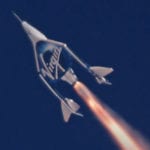 Our World
Our World  Our World
Our World  Animals
Animals 10 Times the Christian Church Took on the Animal Kingdom
 Weird Stuff
Weird Stuff 10 Big Ideas Born in British Pubs
 Travel
Travel 10 Perilous Hikes Still Open to the Public Today
 Facts
Facts 10 Terrifying Facts You Never Wanted to Know
 Weird Stuff
Weird Stuff 10 Fascinatingly Gross Secrets About Your Body
 Miscellaneous
Miscellaneous 10 Groundbreaking & Historical “Firsts” We Witnessed in 2025–So Far!
 Humans
Humans 10 Clever Ways People Have Cheated at Casinos
 Weird Stuff
Weird Stuff 10 Normal Items You Didn’t Know Were Once Part of Burial Rituals
 Misconceptions
Misconceptions 10 Misconceptions in Art & Architectural History
 Our World
Our World 10 Things That Will Make You Rethink Everything Normal
 Animals
Animals 10 Times the Christian Church Took on the Animal Kingdom
 Weird Stuff
Weird Stuff 10 Big Ideas Born in British Pubs
Who's Behind Listverse?

Jamie Frater
Head Editor
Jamie founded Listverse due to an insatiable desire to share fascinating, obscure, and bizarre facts. He has been a guest speaker on numerous national radio and television stations and is a five time published author.
More About Us Travel
Travel 10 Perilous Hikes Still Open to the Public Today
 Facts
Facts 10 Terrifying Facts You Never Wanted to Know
 Weird Stuff
Weird Stuff 10 Fascinatingly Gross Secrets About Your Body
 Miscellaneous
Miscellaneous 10 Groundbreaking & Historical “Firsts” We Witnessed in 2025–So Far!
 Humans
Humans 10 Clever Ways People Have Cheated at Casinos
 Weird Stuff
Weird Stuff 10 Normal Items You Didn’t Know Were Once Part of Burial Rituals
 Misconceptions
Misconceptions 10 Misconceptions in Art & Architectural History
10 Facts About SpaceX And How It Is Revolutionizing Space Travel
The brainchild of entrepreneur and futurist Elon Musk, SpaceX was founded in 2002 as an attempt to rekindle public interest in space exploration and spur funding for NASA. Also, Musk really wanted to launch skyscraper-sized missiles into Earth’s orbit. And honestly, who wouldn’t?
The South African–born visionary’s ultimate goal is to enable multiplanetary human existence by drastically reducing the cost of launching material into space. With our current technology, escaping Earth’s gravity is not easy and comes with a hefty price tag.
For example, it will cost about $500 million to send NASA’s Space Launch System (SLS)—currently, the most powerful rocket to ever be developed—to low Earth orbit with about 70,000 kilograms (150,000 lb) of payload.
SpaceX’s latest and greatest, the Falcon Heavy, can do about the same for approximately $90 million dollars—less than one-fifth of the SLS and its equivalents. So what is the secret behind this unprecedented efficiency, and what exactly does Elon Musk have in mind for the future?
10 SpaceX
Rocky Beginnings To Roaring Success

In 2002, founding an aerospace technology company was objectively a high-stakes gamble. In a climate already dominated by industry giants like Boeing and Lockheed Martin, getting a start-up off the ground posed many challenges, with funding chief among them.
Elon Musk had thus far made a name for himself by defying the odds, having dropped out of a PhD program at Stanford after only two days to pursue his entrepreneurial interests during the dot-com bubble. However, early failures in 2006 and 2007 to launch beta versions of the SpaceX flagship Falcon 9 left the company nearly destitute.[1]
Musk had already invested up to $100 million of his personal finances into seeing the space technology company succeed, and by 2008, it was do or die. Fortunately, billionaire entrepreneur and venture capitalist Peter Thiel, also a cofounder of PayPal, stepped in at the last moment and became SpaceX’s first outside investor. Thiel’s capital breathed new life into the company’s rickety legs, and progress has been steady ever since.
Now, this is not to say that SpaceX hasn’t had plenty of problems since its rejuvenation. If it hadn’t, then it wouldn’t be much of an aerospace company now, would it? Crashing and burning simply comes with the territory.
In 2014–15, SpaceX waged a legal battle with the United States Air Force for awarding launch contracts essentially without competition to the United Launch Alliance, a joint venture between Boeing and Lockheed Martin. Add to this its myriad of launch and landing failures throughout the late 2000s and early 2010s.
But its successes now seem to far outweigh its missteps. The company boasts multiple government, military, and private satellite contracts and has launched around 50 Falcon 9 rockets (some of them reused). The company is now valued above $20 billion. From all this, it is safe to assume that the future for SpaceX rests in the stars.
9 The Merlin 1D
A True Wizard In The World Of Rockets
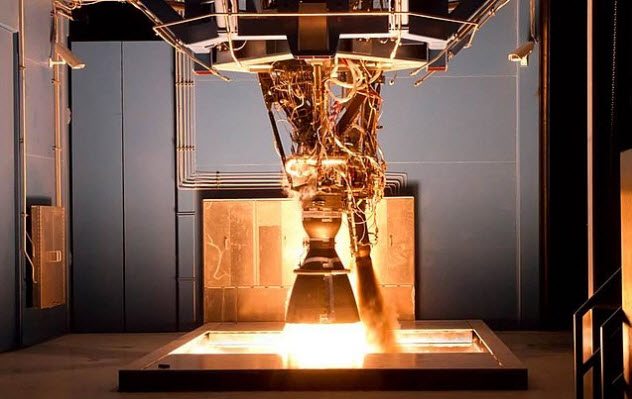
The Merlin 1D is the fourth booster engine in the family of Merlin engines that propel the Falcon 9. In February 2018, the Falcon Heavy was launched hundreds of miles above the Earth’s surface. A single Merlin engine at maximum output emits 845 kilonewtons (190,000 lb) of thrust while only weighing about 470 kilograms (1,030 lb). This grants it the largest thrust-to-weight ratio of any booster engine ever designed or built. For some perspective, a single Merlin’s thrust is equivalent to the weight of 17 adult African elephants.[2]
Each engine is actually self-cooled by the rocket’s fuel supply of high-pressure kerosene. This is one of the factors that has helped reduce the overall bulk of the engine as separate coolant tanks are not required. The Falcon 9 booster is fitted with 9 Merlin engines, any two of which can fail mid-flight and not hinder the mission’s outcome.
Beyond this, the engines are rated to perform within the structural and thermal limits required to carry astronauts. This means we will inevitably see a private company sending men and women to the International Space Station (ISS) within the next few years!
8 Rinse And Repeat
Turning Rockets Into Airplanes
In the early 2000s, after realizing that purchasing refurbished Russian ICBMs to propel his ambitions into orbit wouldn’t be financially viable, Musk decided to build his own rockets. The idea was to produce about 85 percent of the necessary materials in-house, which would help to radically cut back on production costs due to the expensive nature of subcontracting parts.
The next step toward greater efficiency comes with total reusability of the rocket. This makes complete sense as well. If you go to the trouble of designing and building a multimillion dollar rocket, it’s logical to attempt to recover the entire thing as opposed to crashing it into the ocean. Just imagine how expensive air travel would be if you were flying on a newly christened aircraft each time you took a trip.
While reusability is nothing new to a material economy, it’s quite a bit harder to apply to 20-story rockets. SpaceX is the first to employ propulsive landing in Earth’s atmosphere. Each Falcon booster uses a combination of onboard telemetry computers, retractable grid fins and landing legs, and booster engines capable of angling their direction of thrust to land safely.
On December 21, 2015, the Falcon 9 made its first successful landing after several near misses earlier that year. Since then, SpaceX has landed 21 out of 26 attempts, with the most recent 17 landings being consecutive (including the Falcon Heavy).
Musk’s hope is to eventually be able to reuse the Falcon boosters thousands of times so as to reduce the capital cost per launch from about $60–$90 million to under $50,000. By insisting on a 100 percent reusable system, the only costs each flight would incur would be fueling (the price of which pales in comparison to building the rocket) and some other overhead, including prelaunch inspections.[3]
With a fairly impressive track record throughout 2017 and into 2018, it would seem that SpaceX is well on its way to meeting that demand.
7 Cargo Delivery To The International Space Station
That’ll Be $150 Million

Beginning in 2009, NASA awarded SpaceX a $1.6 billion contract to begin resupply missions to the ISS. Coming on the heels of the space shuttles’ retirement, this agreement marked the first time that NASA would rely on a private company to deliver cargo to the station.
Over an eight-year period, SpaceX was charged with sending a minimum of 20 metric tons of supplies—including food, water, and scientific equipment—to rendezvous with the ISS in low Earth orbit. In 2015, SpaceX president Gwynne Shotwell said that each of the three planned missions for that year was valued at around $150 million. Since 2016, NASA has signed on for another 14 resupply missions with SpaceX.
The contract between NASA and SpaceX is a standard money-for-services style of interaction. Although $150 million per mission may seem like a lot, it is a fraction of what NASA and US taxpayers would pay if they were to oversee development of their own launch and payload vehicles. NASA is also assisting SpaceX in the development of its crewed Dragon capsule. Combined with the Falcon 9, the Dragon will take astronauts to the ISS within several years.[4]
As with the far cheaper resupply missions, the development of the manned Dragon capsule is projected to cost NASA about $17 billion less than the design and construction of their own vehicle, the Orion. Per launch, it is expected that the Dragon will again be cheaper by a significant margin. It would seem that the future of space travel currently lies in a partnership between private space corporations and government agencies.
6 Planned Colonization Of Mars
When Can I Buy My Ticket?
Everything that SpaceX has worked for so far has been in service of its founding vision: making humanity a multiplanetary species. In 2017, Musk said, “You want to wake up in the morning and think the future is going to be great—and that’s what being a spacefaring civilization is all about. It’s about believing in the future and thinking that the future will be better than the past. And I can’t think of anything more exciting than going out there and being among the stars.”
For the past 10 years, the company has worked to perfect propulsive landing technology, optimize boosters to become as close to 100 percent reusable as possible, and experiment with carbon fiber space frames to produce lighter, stronger vehicles that cost less than those made from traditional materials.
The purpose of all these advancements is to make a trip to Mars financially feasible, as in $500,000 per ticket instead of several billion. Musk believes that the cost could dip below $100,000 with a continued refinement of the reusable technology.[5]
The timeline for Mars is fast and furious, with at least two cargo missions to the red planet scheduled for as soon as 2022. Two years later, Musk and his team intend to send four ships to Mars, two carrying additional supplies and two carrying crews of astronauts. The enabler of these ambitions is the massive rocket code-named the BFR.
5 The BFR
One Rocket To End Them All
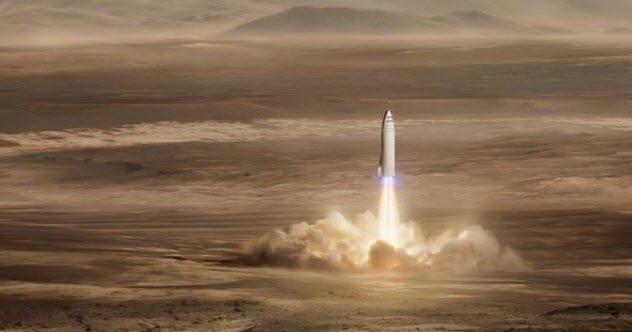
Once constructed, the Big F—king Rocket (BFR) will be the most powerful rocket ever made—and for good reason. It must be able to lift the equivalent of a blue whale’s weight in cargo and people into orbit. The rocket is a single stage to orbit design. (By comparison, the current Falcon 9 and Heavy rockets are two stages.) This means the entire rocket is completely reusable.
As a result, the BFR, a design almost 12 times as powerful as the Falcon 9, will be cheaper to launch and far more versatile. The endgame is for the BFR to replace all of SpaceX’s vehicles currently in operation: the Falcon 9, Heavy, and Dragon capsule.
A spaceship or a tanker vehicle can be mounted atop the booster. The spaceship can land anywhere in the solar system and has a planned capacity of 100 people, their cargo, and other supplies for a total mass of 150 tons. It has a pressurized volume of 825 cubic meters (29,000 ft3), which is greater than the main deck of an A380 commercial airliner.
In its Mars transit configuration, it is planned to have 40 cabins (which can comfortably house two to three people each), a galley, several large common areas, an entertainment center, a solar storm shelter, and a large cargo hold.
If that doesn’t seem impressive enough, you could give the aforementioned blue whale a partner and a baby and happily fit all of them inside the spaceship. The tanker vehicle will have the same space frame as the spaceship, but it will be filled with liquid methane and liquid oxygen fuel.
BFR’s design is truly monstrous. The booster with payload vehicle attached stands 106 meters (348 ft) off the ground and 9 meters (30 ft) in diameter, on par with the Saturn V rocket which carried men to the Moon. The proposed system will send the spaceship and all its occupants and cargo to a “parking orbit.”
While the spaceship waits, the booster will return to its launchpad via propulsive landing and be mounted with the tanker. Then the booster will blast off again and propel the tanker to rendezvous with the spaceship. The tanker will refuel the spaceship and return to Earth with the booster as the spaceship departs for Mars.
At a speed of 100,000 kilometers per hour (62,000 mph), the passengers aboard the spaceship will become the fastest humans to have ever lived and will reach Mars within three months.[6]
4 Rockets For International Transit
Fly Anywhere In The World In Under An Hour!
Alongside Elon Musk’s Mars plan, he has posed this question: If SpaceX is building a rocket to travel to the Moon and Mars, then why not use the BFR to travel to other places around the world, too? Due to the BFR’s 100 percent reusability, it is conceivable that it could be used for incredibly fast travel from country to country.
Musk says that it would be necessary to find spots for the rocket to take off and land that are somewhat removed from big cities because “rockets are quite noisy.” But most of your travel time would be spent getting to the launchpad. From there, it would be quite a short flight. On top of this, once you are free of Earth’s atmosphere, your flight would be “silky smooth” with no air to cause turbulence or bad weather.
Most heavily trafficked commercial airline routes such as LA to New York, London and Paris to New York, LA to London, and London to Hong Kong could be completed via BFR in anywhere from 25 to 35 minutes.[7] There has been no official quote on the price of tickets for these flights, but it can be assumed that they will be relatively expensive at first due to the technological infancy of this type of air . . . er, excuse us . . . space travel.
3 The Most Powerful Rocket In The World
Falcon Heavy February 6 Launch
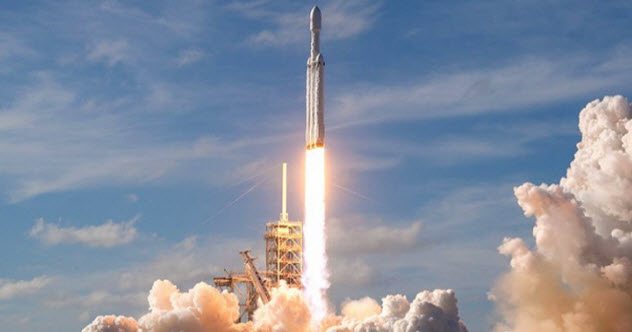
The Falcon Heavy is an extension of the Falcon 9 and is currently the heavy-lifting vehicle for Musk’s company. Since the Saturn V, no rocket has been as powerful. Similar in height to the Falcon 9 but boasting two additional Falcon 9 first-stage boosters, the Falcon Heavy is composed of three engine cores and a second-stage payload rocket mounted atop the middle core.
Its thrust at liftoff is 22,819 kilonewtons (5.13 million pounds), and it is capable of transporting 64,000 kilograms (140,000 lb)—about 10 African elephants—of material to low Earth orbit, 17,000 kilograms (37,000 lb) to Mars, and almost 3,600 kilograms (8,000 lb) to Pluto![8]
On February 6, 2018, SpaceX’s Falcon Heavy rocket took off from historic Pad 39a at the Cape Canaveral launch center in Florida, the same launchpad that saw Apollo missions send men to the Moon. The mission was a huge milestone for SpaceX, which is now the only commercial space company to have sent a payload beyond Earth’s gravity.
The simultaneous landing of the two outer core Falcon boosters is a demonstration of SpaceX’s increasing mastery of reusable rocket technology. Upon the outer cores’ reentry, it was possible to hear six sonic booms emanate from each of the boosters’ lower sections, landing legs, and grid fins.
The middle core missed its landing mark on one of SpaceX’s autonomous ocean drones by about 100 meters (330 ft) and collided with the Pacific at roughly 485 kilometers per hour (300 mph). Musk later clarified that the center core had been unable to reignite two of its engines for the crucial landing burn that would slow the booster from supersonic speed to a gentle touchdown.
In typical whimsical SpaceX fashion, the dummy payload that was used to test the rocket’s lifting capacity was Elon Musk’s own Tesla Roadster. An astronaut mannequin affectionately nicknamed “Starman” (in tribute to David Bowie’s song) is its passenger. The mannequin wears the spacesuit that SpaceX is currently developing.
The roadster was sent on a trans-Mars orbit, which means there is a car traveling through space toward Mars at about nine times the speed of sound. Its projected orbit takes it on an elliptical path several million miles beyond Mars before looping back around the Sun.
However, due to the carbon composite structure of the car and the prevalence of radiation and microscopic debris in space, chemists say that most of the car will probably disintegrate within a year.
2 You Can Track Starman’s Progress Through The Solar System
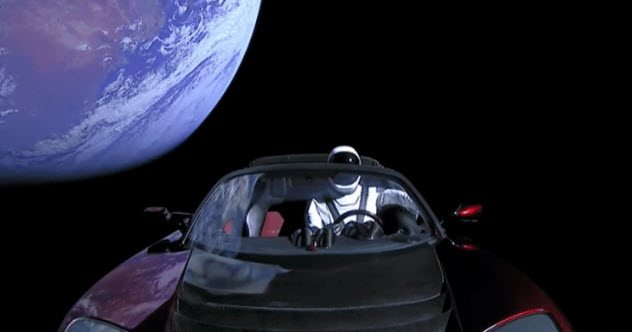
On the heels of the February 6, 2018, Falcon Heavy launch, electrical engineer and aerospace industry worker Ben Pearson created a website, www.whereisroadster.com, that tracks Starman and his cherry red roadster as they hurtle through space.[9]
The site gives the velocity and position data relative to Earth, Mars, and the Sun. It also provides a simulation of Starman’s orbit around the Sun and even quippy bits of data like the estimated gas mileage and how many times the roadster has so far exceeded its lifetime warranty.
Pearson’s simulation is based on data he receives from the JPL HORIZONS system, which is an online compendium of solar system object tracking used for asteroids, comets, satellites, and spacecraft. Pearson has also calculated a series of close approaches, or when the roadster will be within some fraction or multiple of an astronomical unit of Earth or Mars. An astronomical unit is the distance from the Earth to the Sun or about 150 million kilometers (93 million mi).
Pearson created the website shortly after the launch. He realized that there would probably be a significant audience, himself included, for tracking the rather comical display.
1 Starlink Initiative And An Attempt To Recover Falcon 9’s Nose
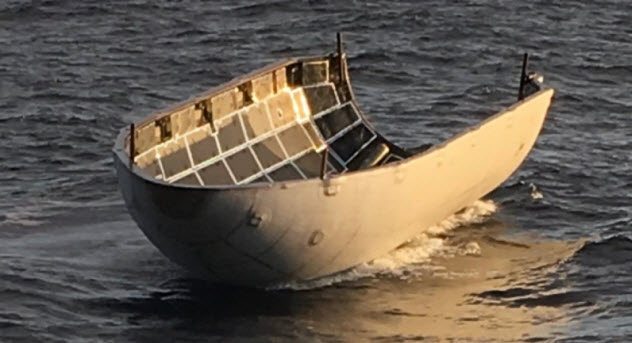
On February 22, 2018, the PAZ and Starlink satellites were launched into orbit aboard a Falcon 9 booster. PAZ is a Spanish military satellite for security and defense. The Starlink satellites are the preliminary test craft for SpaceX’s Starlink initiative which aims to provide global broadband Internet access by 2024.
Code-named Tintin A and B, these two satellites will serve as proof of concept while SpaceX waits for FCC approval to launch many hundreds—and eventually thousands—more. The satellites will communicate with each other and ground stations via optical lasers, beaming Internet access anywhere from Antarctica to an African village.
Following the launch, SpaceX attempted to recover half of the upper stage’s fairing using their fairing recovery boat named Mr. Steven. The fairing is the nose cone of the rocket which protects the payload on ascent and is vital to the vehicle’s aerodynamic frame.[10]
After the second stage has exited Earth’s atmosphere, there is no air to resist the motion of the spacecraft and so the fairing splits into two pieces and falls back to Earth. Each piece is valued at about $3 million, together totaling about 10 percent of the launch cost.
In painstaking efforts to make every part of the rocket reusable, the fairing, alongside the booster, must be recovered. That’s where Mr. Steven comes in. The boat positions itself underneath the fairing as it falls and uses a giant net (like a baseball glove) to catch it.
The fairing itself uses cold gas thrusters and a large parachute to guide it to a specific point over the ocean and to slow down from its reentry speed of eight times the speed of sound. Unfortunately, Mr. Steven missed the fairing by just several hundred feet this time, but it eventually recovered the nose cone and proudly sailed back into harbor with it in tow.
SpaceX intends to eventually have multiple Mr. Stevens, although likely under different names, to help with their increasingly busy launch schedule.
I am currently an undergraduate at the University of California, Berkeley, studying astrophysics. I’ve always had a love for science fiction, in particular Star Trek, Battlestar Galactica, and most recently, The Expanse. In my free time, I enjoy writing, drawing, and running.
For more exciting facts about SpaceX and space travel, check out 10 Things We Know About Elon Musk’s Future Colony On Mars and 10 Obscure Issues That Hinder Manned Missions To Mars.





